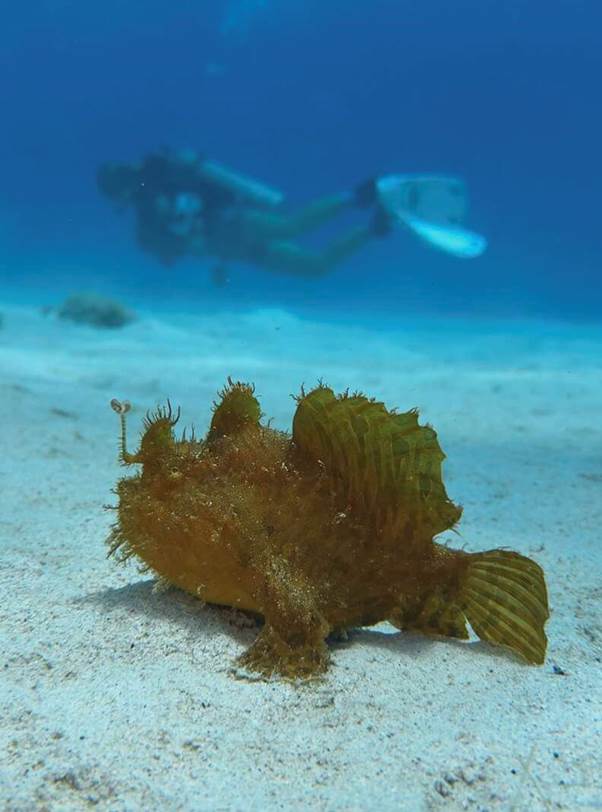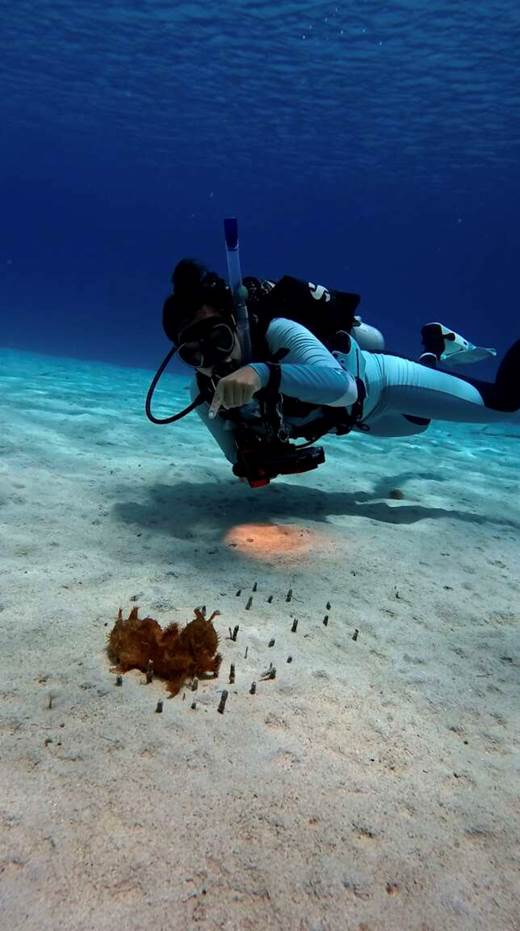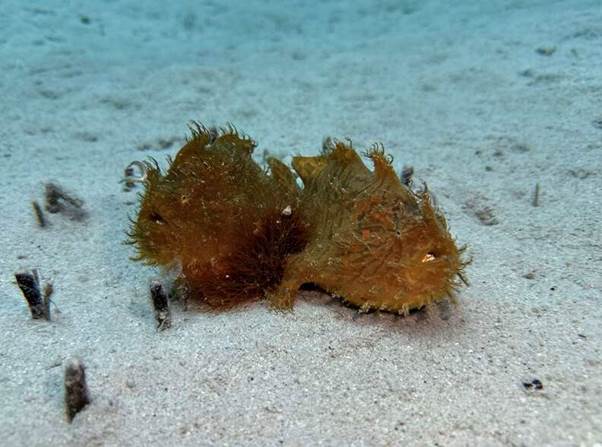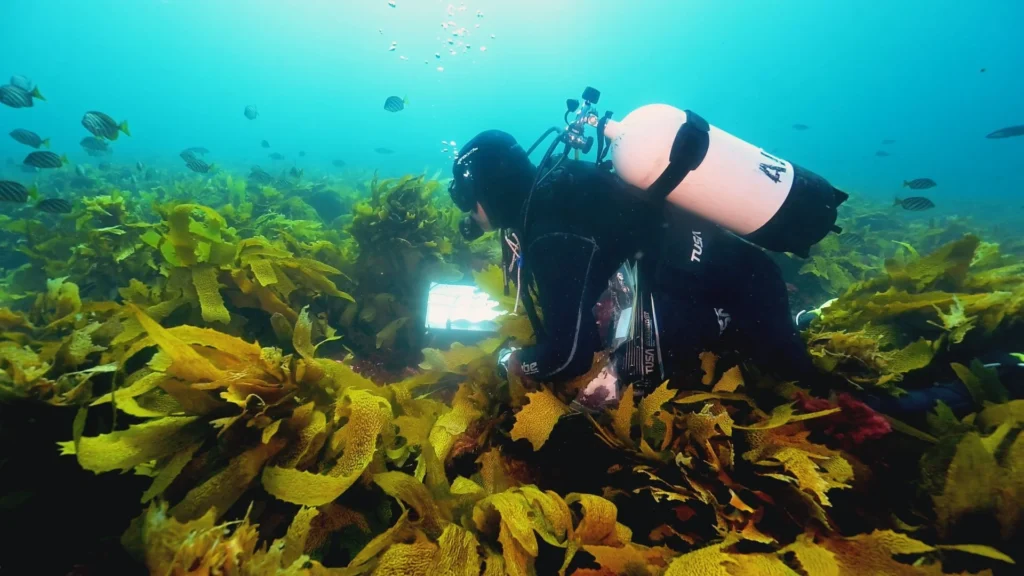A Rumor Sparks Curiosity
For scuba diving content creator Jorinde Maré, the ocean has always been a place of wonder. Based in Bonaire, a Caribbean island blessed with turquoise waters and thriving coral reefs, she has spent countless hours beneath the waves documenting marine life. Every dive is a chance to discover something new, but even seasoned divers don’t often stumble upon creatures that leave them speechless.
That changed when Maré received a message from her close friend and fellow diver, Jolanda. During a routine dive, Jolanda had spotted something so unusual that she wasn’t sure anyone would believe her: a striated frogfish, a rare type of anglerfish known for its incredible camouflage.
Striated frogfish are masters of disguise. With their mottled skin, streaks, and ability to change color, they can look like rocks, coral, or even drifting seaweed. To the untrained eye, they appear lifeless — until they suddenly move. They also carry a strange worm-like appendage on their heads, which they wiggle like fishing bait to lure in prey. To divers and marine photographers, spotting one feels like winning the underwater lottery.
The problem was, no one had ever seen one in Bonaire. Not Jolanda, not Maré, and not the dive professionals they spoke with afterward. “I talked to many people in the dive industry here,” Maré said, “and for all of them, it was surprising.”
The thought of such a rare species quietly inhabiting Bonaire’s waters filled Maré with excitement. She knew she had to try to find it for herself.

The Search Begins
Armed with her scuba gear and Jolanda’s directions, Maré set out on her first frogfish hunt. She hovered above sandy patches, peered into coral crevices, and carefully inspected anything that looked unusual. Her heart raced each time she thought she might have spotted something. But every time, it turned out to be exactly what it looked like — a clump of seaweed, a sponge, or a piece of coral.
By the end of that dive, she had seen plenty of marine life but no frogfish. “We were obviously disappointed,” Maré admitted. Still, she refused to give up.
A few days later, she tried again. This time she was more focused, studying every inch of the ocean floor. But again, she came up empty-handed. Her excitement was starting to wane. Had Jolanda’s frogfish moved on? Had it only been passing through?
Many divers would have stopped after two failed attempts. But Maré’s curiosity and determination pushed her to schedule a third dive. She told herself that even if she didn’t find the frogfish, she would at least spend another beautiful day underwater.

A Perfect Disguise Revealed
That persistence paid off. On her third dive, while swimming just 10 feet below the surface, Maré noticed what looked like a limp piece of seaweed resting on a sandy patch. At first, she almost dismissed it. But then she noticed something unusual — the “seaweed” had tiny eyes.
Her breath caught in her regulator. She had finally found it — the striated frogfish.
Maré floated perfectly still, marveling at how flawlessly the creature blended into its surroundings. If she hadn’t been paying close attention, she would have swum right past it. “This species looks just like a piece of seaweed on the sandy floor,” she later wrote on TikTok, where she shared the footage of her discovery.
Just when she thought the dive couldn’t get any more magical, it did. As she and her dive buddy swam a little farther, they came across two more frogfish huddled together over another sandy patch. One sighting would have been incredible; three in a single dive was almost unbelievable.
“We were absolutely thrilled,” Maré recalled. “It was quite the sight to see.”

Why This Discovery Matters
Striated frogfish aren’t endangered, but they are notoriously difficult to find. Their camouflage makes them nearly invisible, even to experienced divers, and their preferred habitats don’t usually include Bonaire. Seeing three in such close proximity raised new questions for Maré and for the local dive community.
“More research is needed to determine whether these striated frogfish showing up outside of their usual habitat is a complete anomaly or a sign that they’re expanding their home territory,” Maré explained.
If it’s just a rare occurrence, divers may have to wait years for another sighting. But if frogfish are truly moving into Bonaire’s waters, it could signal changes in the local marine ecosystem — possibly linked to shifting ocean temperatures, currents, or food availability. Either way, encounters like Maré’s provide valuable insight into the health and diversity of marine environments.
For Maré, though, the scientific questions were just part of the story. The experience also reminded her why she loves diving in the first place. Even after years of exploring the same waters, the ocean still had the power to surprise her.
“It was a dream come true,” she said. “You never know what the ocean will show you.”

A Lesson From the Ocean
Seeing the frogfish wasn’t just about checking a rare species off a list — it was about being humbled by the mysteries of nature. The frogfish, with its odd appearance and quirky hunting methods, isn’t traditionally beautiful like a sea turtle or a dolphin. Yet it plays an important role in its ecosystem, helping to maintain balance by preying on smaller fish and crustaceans.
For divers like Maré, encounters with unusual creatures underscore the need for conservation. “Animals like the frogfish rely on healthy reefs and clean waters to survive,” she explained. “When you see them up close, you realize how delicate and interconnected everything is.”
The discovery also highlighted the value of persistence. Had Maré given up after her first or second attempt, she never would have witnessed one of the most exciting dives of her life. Instead, her patience and determination were rewarded with not one, but three extraordinary encounters.
Now, whenever she dives, she does so with a renewed sense of possibility. “Every dive is different,” she said. “Even in places you know well, there’s always the chance of discovering something incredible.”


